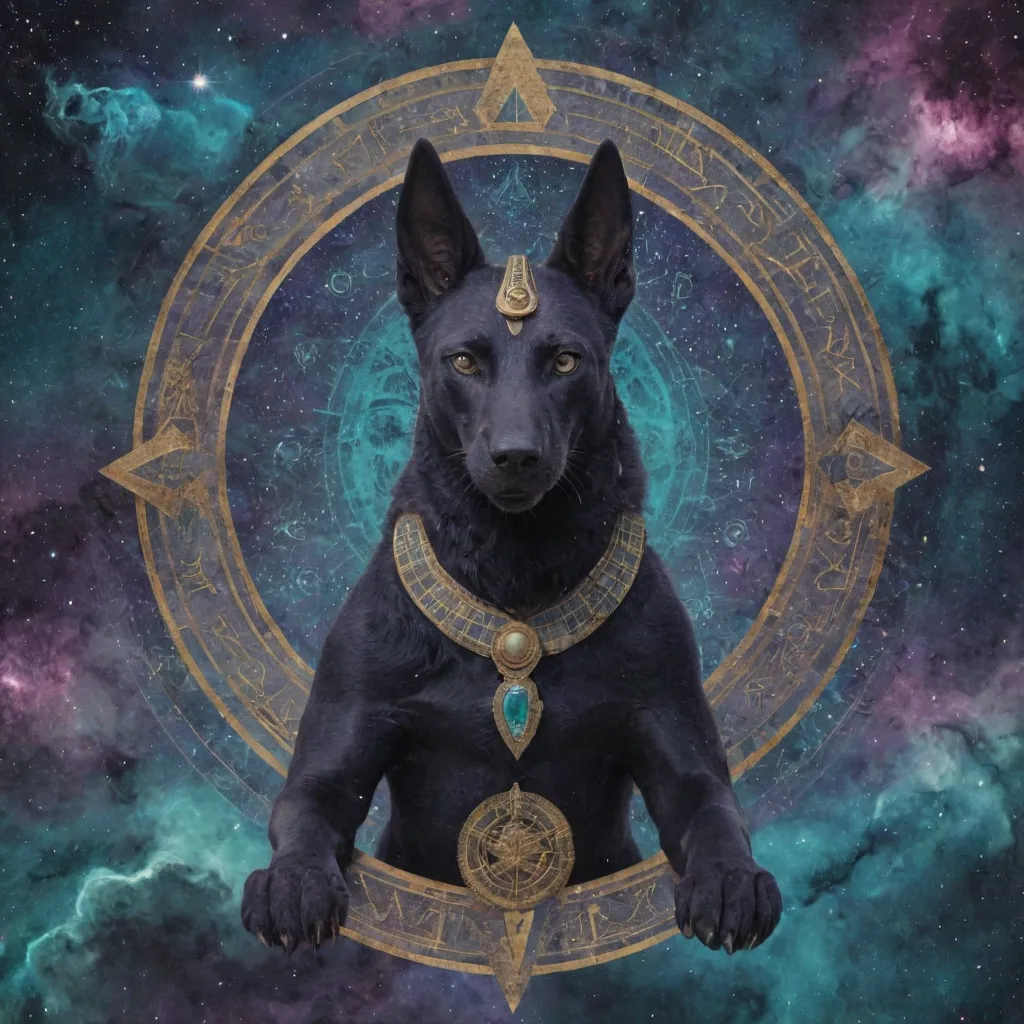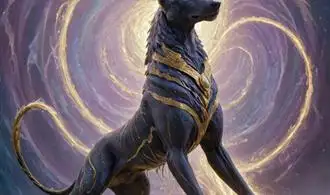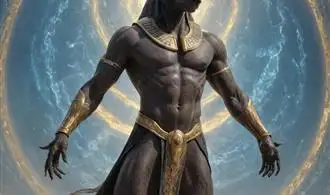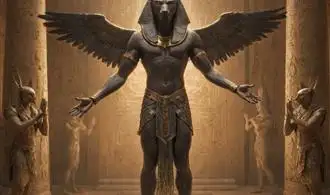
The Origins of Anubis
Anubis, the jackal-headed deity, holds a prominent place in ancient Egyptian mythology and religious practices. This enigmatic figure has captivated the imaginations of scholars and enthusiasts alike, with its symbolism and significance deeply rooted in the rich tapestry of Egyptian culture. To understand the symbolism of Anubis, it is essential to delve into the origins and evolution of this revered deity.
Anubis's origins can be traced back to the predynastic period of ancient Egypt, where the jackal was revered as a sacred animal. This connection to the jackal likely stems from the animal's propensity to prowl around cemeteries and feed on the deceased, which was interpreted as a connection to the afterlife and the realm of the dead. Over time, the jackal-headed deity emerged as a central figure in funerary rites and the protection of the dead.
One of the earliest known depictions of Anubis dates back to the First Dynasty, where the deity was represented as a jackal or a jackal-headed human figure. This early iconography highlighted Anubis's role as the guardian of the necropolis, the sacred burial grounds where the deceased were interred. The jackal-headed figure was believed to oversee the mummification process, ensuring the proper preparation of the body for the afterlife.
As Egyptian religious beliefs and practices evolved, Anubis's role and symbolism expanded. The deity became associated with the embalming and mummification of the deceased, with Anubis being responsible for the delicate process of removing the internal organs and preserving the body. This connection to the mummification process cemented Anubis's status as a crucial figure in the journey to the afterlife, guiding the deceased through the transition from the physical world to the realm of the dead.
Furthermore, Anubis was believed to weigh the heart of the deceased against the feather of truth, a ritual known as the "Weighing of the Heart." This judgement of the soul determined the individual's worthiness to enter the afterlife, with Anubis playing a pivotal role in this crucial moment. The successful completion of this ritual ensured the deceased's safe passage to the afterworld, solidifying Anubis's position as a gatekeeper and protector of the dead.
The Representation of Anubis in Ancient Egyptian Art
Anubis, the jackal-headed god, was a central figure in ancient Egyptian mythology and art. As the god of the dead, embalming, and the afterlife, Anubis played a vital role in the funerary rituals and beliefs of the Egyptian people. The depictions of Anubis in ancient Egyptian art offer a rich and intricate tapestry of symbolism, revealing the depth of his significance within the Egyptian pantheon.
One of the most striking aspects of Anubis's representation in ancient Egyptian art is the consistent use of his distinctive jackal-like head. This distinctive feature served to immediately identify Anubis, even in the most abstract or stylized depictions. The jackal was chosen as Anubis's animal form due to its association with the desert, where many burials took place, as well as its scavenging behavior, which was seen as a connection to the process of mummification and the care of the dead.
In addition to the jackal head, Anubis was often depicted holding specific objects or performing particular rituals. For example, Anubis was frequently shown kneeling beside a mummy, with his hands placed in a protective or ceremonial gesture. This image symbolized his role as the guardian of the dead, responsible for the proper preparation and protection of the deceased during their transition to the afterlife. Discover the Fascinating History of Anubis Artwork to further explore the artistic and cultural significance of this important deity.
Another common representation of Anubis in ancient Egyptian art was the depiction of the god standing or sitting, holding a Was scepter, which was a symbol of power and authority. This image highlighted Anubis's role as a powerful and influential deity, responsible for overseeing the crucial rituals and processes associated with the afterlife.
The artistic representation of Anubis also evolved over time, with different styles and techniques employed to capture the deity's essence. From the bold, iconic images found on temple walls to the intricate, detailed depictions on funerary objects, the artistic renditions of Anubis offer a window into the changing cultural and religious beliefs of ancient Egypt.
The Funerary Role of Anubis
Anubis, the jackal-headed god of ancient Egypt, played a crucial role in the funerary rituals and beliefs of the ancient Egyptians. As the god of embalming and the protector of the dead, Anubis was responsible for guiding the deceased through the complex and mystical process of the afterlife.
One of Anubis's primary functions was the embalming and mummification of the deceased. The Egyptians believed that the body needed to be preserved in order for the soul to return to it after death. Anubis was responsible for overseeing this process, ensuring that the body was properly prepared and protected for the journey to the afterlife.
In the embalming ritual, Anubis would oversee the removal of the internal organs, the drying and preservation of the body, and the wrapping of the body in linen bandages. This was a critical step in the funerary process, as the Egyptians believed that the body needed to be intact and preserved for the soul to return to it.
Anubis was also responsible for guiding the deceased through the weighing of the heart ceremony, a crucial step in the journey to the afterlife. During this ceremony, the heart of the deceased was weighed against the feather of truth, and if the heart was found to be pure, the deceased was allowed to pass into the afterlife.
Anubis's role in the funerary rituals and beliefs of the ancient Egyptians was not limited to the embalming and the weighing of the heart. He was also believed to be the protector of the dead, guarding the tombs and the mummies of the deceased from harm.
The Duality of Anubis
Anubis, the ancient Egyptian deity associated with the afterlife, is a figure of profound duality. As the jackal-headed god who presided over the mummification process and the journey to the underworld, Anubis embodied both the darkness of death and the light of rebirth. This dichotomy is central to understanding the symbolism and significance of this enigmatic deity.
At the heart of Anubis' duality lies the concept of transformation. As the patron of the embalming ritual, Anubis oversaw the process by which the deceased were prepared for the afterlife. This transformation from mortal to immortal, from physical to spiritual, is a testament to the god's power to guide the dead through the treacherous passage to the next realm. Yet, Anubis was also seen as a protector, a guardian who ensured the safe passage of the soul and the preservation of the body.
The dual nature of Anubis is further reflected in his iconography. The jackal, the animal associated with the god, was revered for its cunning and adaptability, but also feared for its predatory nature. Similarly, Anubis was both a comforting presence, offering solace and guidance to the departed, and a formidable figure, wielding the power to determine the fate of the soul in the afterlife.
This duality is also evident in the roles Anubis played in the Egyptian pantheon. As the overseer of the mummification process, he was closely associated with the preservation of the physical body, ensuring that the deceased were prepared for the afterlife. Yet, he was also seen as a psychopomp, guiding the soul through the treacherous underworld and into the realm of the divine.
Anubis in Modern Symbolism and Occult Practices
Anubis, the ancient Egyptian deity associated with mummification and the afterlife, has long been a captivating figure in the realm of symbolism and occult practices. In modern times, this enigmatic god has continued to capture the imagination of scholars, artists, and those drawn to the mystical. To understand the symbolism of Anubis, one must delve into the rich tapestry of his historical significance and the ways in which his representation has evolved over the centuries.
At the heart of Anubis's modern symbolism lies his traditional role as the guardian of the dead and the embalmer of the deceased. In ancient Egypt, Anubis was responsible for overseeing the mummification process, ensuring the proper preservation of the body and its journey into the afterlife. This aspect of Anubis's character has resonated deeply with those exploring the occult, as the process of transformation and rebirth has long been a central theme in many esoteric traditions.
In modern occult practices, Anubis is often invoked as a guide and protector, assisting practitioners in their own journeys of self-discovery and spiritual growth. His connection to the afterlife and the underworld has made him a popular figure in rituals and meditations focused on the exploration of the subconscious and the exploration of the unknown. Practitioners may seek Anubis's guidance in matters of death, rebirth, and the transition between the physical and spiritual realms.
Moreover, Anubis's association with the embalming process has led to his symbolism being applied in more practical, occult-based contexts. Some practitioners may incorporate Anubis's energies into spellwork and rituals focused on preservation, protection, and the sanctification of sacred spaces. The deity's influence may be felt in the creation of talismans, amulets, and other occult objects meant to safeguard individuals or facilitate the transformation of the self.
One notable example of Anubis's modern occult relevance can be found in the practice of channeling the Anubis deity. Through this process, practitioners seek to connect with the essence of Anubis, inviting his wisdom and guidance into their lives. This practice allows individuals to gain a deeper understanding of Anubis's symbolism and the insights he can offer on the nature of death, the afterlife, and the mysteries of the human experience.
















